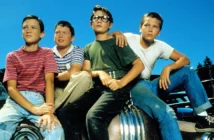India speaks of Dilip Kumar as the West speaks of Humphrey Bogart or Marlon Brando, and this is no exaggeration. Dilip Kumar represented a cinematic prowess, a stinging charm, which no other Indian actor has been able to match to date. He was the boss of Indian cinema — and when I say ‘Indian cinema’, I stand by it. He was the actor with a thousand faces, the last authentic tragedian India witnessed in its chourahas, the colourful but beaten lanes, and cinema ghars, of course. Certainly, he is one of those stars writers like me are scared of writing about! Not only because the sheer volume of their careers cannot be contained in a few hundred or thousand words, but also because they are everyone’s favourite, and one inappropriate word or sentence, and our jobs can go flying out the window. Just kidding . . . anyway, when we think of Dilip Kumar, we automatically remember some of the most iconic and consecrated films of classical Hindustani cinema: Jugnu (1947), Andaz (1949), Devdas (1955), Madhumati (1958), Yahudi (1958), Mughal-e-Azam (1960), Gunga Jumna (1961), should I name more? These are just some of the titles that capitalised Kumar’s name in the annals of central stardom. Quite interestingly, many of these films accentuated Dilip Kumar in a tragic or melancholic role. This representation has now become the staple of remembering him across different imaginations, which also interlinks with the often-stated speculation that he briefly suffered from depression after taking too many of these tragic roles. This speculation mostly heightens in peoples’ discussion of Guru Dutt’s cult-classic, Pyaasa (1957), wherein the leading role of Vijay was later essayed by Dutt after it was declined by Kumar owing to his mental health.
However, we still saw much of Kumar in other romantic-tragic roles in films like Yahudi (1958) which, I think, was Kumar’s forte. There was an uncanny comfort that he tended to exhibit in these darker roles; there was poise, too, and a sense of composure that his characters often embodied — something that cinephiles might equate with the silence of Kamāl Amrohi’s cinema. His tragic demeanour was not hysterical, neurotic, rampant; instead, it was controlled, yet complex. This feature carries over in Kumar’s later donning of comic roles, like in Ram aur Shyam (1967) — which remains one of those few comedies starring Dilip Kumar. I think after Mughal-e-Azam (1960), Dilip Kumar began diversifying his genre choices and was intermittently seen in crime/political films, social cinema, rural romances, and action films. Being a product of an industry that values the box office, much of Kumar’s cinema since Kranti (1981), therefore, becomes formulaic and “trend-abiding”. The 1980s was the time when Amitabh Bachchan was at his prime, with his ‘angry young man’ persona crossing the farthest threshold of national popularity. Political and action-oriented drama was the producer’s favourite — that was where the box office hits were. So, naturally, India witnessed a Dilip Kumar who re-entered the industry with his ‘angry old man’ personas, though, personally speaking — and on behalf of a few friends — I think the Dilip Kumar from the 1950s was more ground-breaking and convincing. Certainly, the 80s characters he played were more daring and hypermasculine, but I’m more inclined toward his sombre cinema of the 50s.
His 50s characters are the ones that invite more serious deliberation and debate. Because each time you watch Dilip Kumar in these films, you would want to watch him again, and every time you rewatch him, a new side of the actor surfaces. Different facets of a single character re-emerge, and this is the complexity Dilip Kumar achieves in his earlier cinema. I’m not referring to his dual characterisations in films Ram aur Shyam (1967) or Dastaan (1972), but the ones where he plays a single character with complicated pasts and futures, as in Madhumati (1958). Dilip Kumar’s associations with Hindustani cinema have been nothing, but illustrious. It overflows from the borders of India to further establish him as a South-Asian icon, with fans and followers from across different SAARC nations. In 1998, for example, Pakistan conferred him the Nishan-e-Imtiaz, its highest civilian award, making Kumar the only Indian to have received this honour to date. These accomplishments validate Dilip Kumar’s position in the cultural memory of South Asia. And, while we can talk about stars and celebrities, Dilip Kumar highlights iconicity: an unparalleled legacy, a torrential novel, an unending chapter . . .
dedicated to a fan of Dilip Kumar,
Aysel, who runs an Instagram channel
called goldbollywood_ and keeps the
love for retro Bombay cinema alive!



